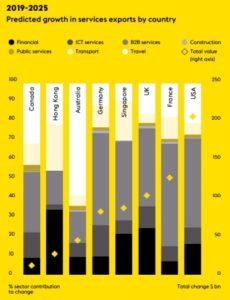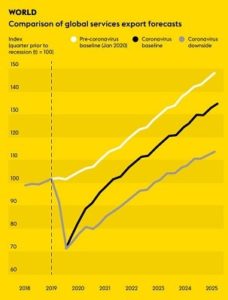Global Trade in Services to Increase by $2trn Over Next Five Years, According to New Report by Western Union and Oxford Economics
Forecasts by Western Union and Oxford Economics project
the value of international, cross-border trade in services
rising from $6.1trn in 2019 to $8.0trn by 2025 – a 31%
increase in value
Amongst developed economies, USA, France, and UK set to
see largest increase in value of cross-border trade in
services by 2025
Adoption of new technology and digitization of working
practices likely to further fuel post-pandemic economic
recovery and growth of cross-border trade in services
Trade policy liberalization could see an additional $890bn
increase in the value of services traded globally
The Western Union Company (NYSE: WU), a leader in
cross-border, cross-currency money movement and
payments, today launches a new report, “The Global
Services Trade Revolutions: Fuelling post-pandemic
economic recovery and growth,” in partnership with Oxford
Economics – a leader in global forecasting and quantitative
analysis.
The report projects the value of international trade in
services* rising from $6.1trn in 2019 to $8.0trn by 2025,
equating to an increase of almost a third (31%) in the
value of global flows over this period.
It is predicted this growth will be accelerated by the
adoption of new technology and digitization of working
practices forced by the onset of the COVID-19 pandemic –
which, combined with a shift in attitudes to online
interactions, is likely to fuel economic recovery and growth
of cross-border trade in services in the coming five years.
Western Union Business Solutions and Oxford Economics’
central forecast scenario envisages a relatively strong
economic recovery, but it is also possible that a more
pessimistic scenario will unfold, characterized by a steeper
near-term contraction and a more prolonged and
incomplete recovery (see Comparison of global services
export forecasts graph). Still, this scenario would only
magnify the relative outperformance of digitally-deliverable
services.
“For far too long the global service industry has been
undervalued and its importance underestimated. This
report shows that this needs to change. The economic
impact of COVID-19 will be felt for years to come, but we
can clearly see that the regions and industries that
recognize and appreciate the value of global services will
be in a better position to drive future success and
ultimately, recovery,” said Andrew Summerill, President,
Payments at Western Union.
Sector breakdown
The analysis suggests while the global economy is suffering
in the short-term, trade in modern digital services will
prove comparatively resilient through the current crisis. It
estimates that the value of cross-border flows of B2B, ICT
and financial services will decline by just 6% in 2020,
compared to the value of goods trade, which will decline an
estimated 13% (see 2019-2025 Predicted growth in
international services trade graph).
Meanwhile, hard-hit traditional services categories such as
tourism will decline by around 40% in 2020, while air
passenger transport will decline by over 50%. As a share of
total services trade, these categories are projected to slide
to 39% by 2025 – down from 41% in 2019.
Geographic breakdown
The report also analysed these trends across eight large
developed economies, finding B2B services will be the main
driver of export growth, with financial services also
important for key hubs like the USA, UK, Hong Kong and
Singapore. Outside this sample, other predicted ‘hotspots’
for digital services export growth over the medium term
include Korea and Japan, Australia and New Zealand, and
Qatar and Saudi Arabia.
The USA will post the largest overall increase in services
exports during the forecast period, the result of its global
leadership in many categories of professional services, as
well as its investments in digital infrastructure and
technological innovation (see 2019-2025 Predicted growth
in services exports by country).
Furthermore, it is estimated a broad, multilateral
liberalization of trade policies on services could provide an
additional 11% boost to the value of global services trade
by 2025, which would equal an $890bn increase in the
value of these cross-border transactions.
“The pandemic has already super-charged the growth in
digital services and highlighted the potential for remote
services to transcend global borders. Over the next decade,
we’re going to see swathes of new business models
redefine the possibilities for cross-border transactions. And
in the short-term, global trade in services will be a vital
component of recovery, and it will be digitally focused
industries that will be the driving force,” added Summerill.
The report, which aims to shine a light on the valuable
contribution that global digital services trade brings to the
economy now and its potential for the future, uncovers that
trade in services has typically been undervalued, when
compared to trade in goods or manufacturing.
The report estimates that services currently account for
more than half (55%) of all global trade flows, equating to
US$13.7trn of cross-border transactions in 2019. Official
statistics state that the share of services in total trade
amounted to 24% in 2019, up from 19% in 1995.1
“Our aim is to champion the industries fuelling economic
growth and recovery and to provide support to boost the
growth of the digital services sector,” concluded Summerill.
To access the report in full, please click here.
Note on research and methodology
The key framework in which Oxford Economics’ analysis is
conducted is its own Global Econometric Model (GEM). The
GEM replicates the world economy by interlinking 80
countries, 6 regional trading blocs and the Eurozone. These
countries are interlinked through international trade in
goods and services, competitiveness (measured by unit
labour costs adjusted for the exchange rate), capital
markets, interest rates and commodity prices. Historic data
and forecasts are updated on a monthly basis by our
country economists.
*Definitions of international trade in services used for this
study:
Business-to-business (B2B) services: Professional services
(e.g. engineering, legal) and royalty & license fees (e.g.
fees for the use of patented technology).
Information and communications technology (ICT)
services: Services related to computers (e.g. software
development) and communication devices (e.g. telephone
services).
Financial services: Activities of the finance industry
including banking, insurance and asset management.
Transport & distribution: Services related to the
international movement of goods (e.g. shipping, air cargo
and cross-border road & rail transport) or transport of
people (e.g. air passenger services).
Tourism & travel: Spending by temporary visitors to
another country for leisure, business or other purposes
such as education or medical tourism (exports are defined
as inbound tourism flows).
Construction: Services relating to the
construction/demolition of buildings and other structures,
as well as installations and building repairs.
Public services: Services commissioned by the public sector.



 التكنولوجيا وأخبارها بوابة الإمارات لتكنولوجيا المعلومات والإتصالات
التكنولوجيا وأخبارها بوابة الإمارات لتكنولوجيا المعلومات والإتصالات





